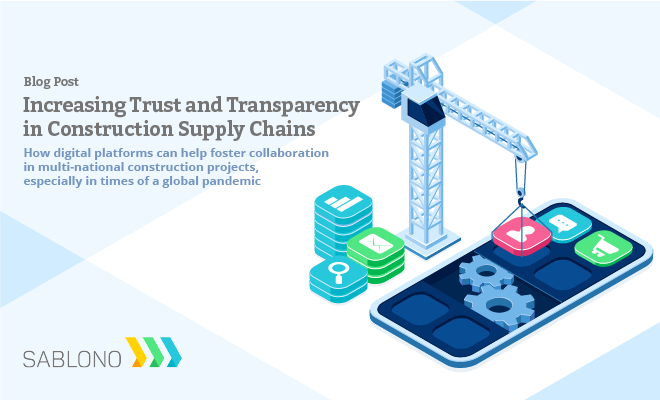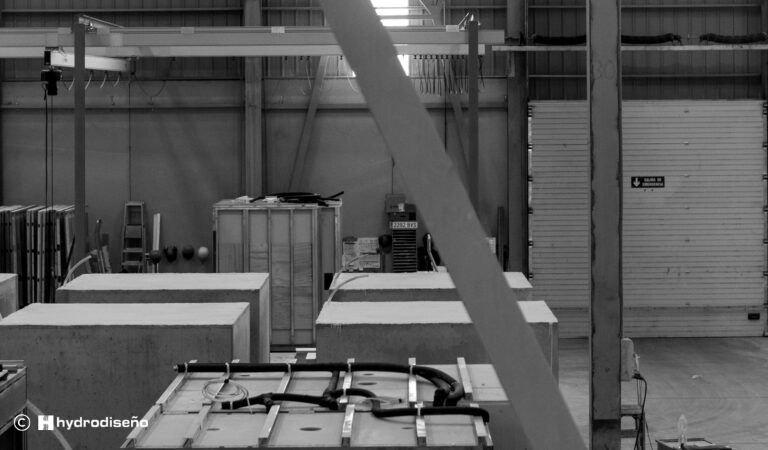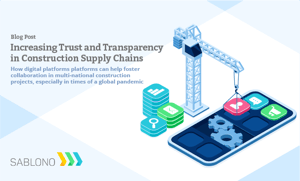
Whether it’s a mammoth cargo ship blown off course by a simple gust of wind or a global pandemic putting countries into national lockdowns, the construction industry can be particularly sensitive to unexpected disruption. With more firms adopting offsite manufacturing and modern methods of construction (MMC), securing quality and reliability in the supply chain has become ever more important. However, in a year which has seen site visits restricted, how do construction firms keep their own projects on track during a pandemic?
The key issues many construction teams have struggled to grapple with during the pandemic are trust and transparency. As construction projects become more dependent on their supply chains, this leads to a growing problem in the industry. Before Covid-19 a lot of Sablono’s clients from the UK flew over to their bathroom, façade or steel manufacturers in Europe or Asia to conduct site visits on an almost weekly basis. However many have now found that the situation with Covid means they cannot meet face to face. But how can a company trust subcontractors, especially if they haven’t worked with them in the past?
In a world where close project management isn’t always possible, effective remote tools to manage supply chains are key. Construction firms have managed to adapt to the “new normal” during Covid by undertaking a number of jobs, such as inspections, remotely via a Teams or Zoom call. But keeping a close eye on the supply chain and quality control has been a challenge.
In normal times, to understand the progress on part of a project, clients would perhaps visit a site, make a call, email, or organise a meeting and maintain their own spreadsheets for each individual package of a project. However they never gain any real-time, comprehensive overview about everything that is happening on their projects in just a blink of an eye.

For many, Excel spreadsheets have been the go-to option for keeping track, however there are inherent problems with this approach. Spreadsheets can be manipulated, data imported in a variety of different ways, and the person receiving the sheet needs to trust that the information put in is correct. Even more problematic, the data becomes outdated very quickly, contains no analytical data or construction BI and is often left unused. Taking action based on reliable data is needed to drive improvements.
Since the pandemic has restricted site visits, many construction firms have sought out Sablono’s expertise in managing data in a real time environment to overcome the travel restrictions without compromising on quality. Initially designed for main contractors to embed their onsite and offsite supply chain, the Construction Execution System is now being adopted by manufacturers themselves to help streamline their own operation and also gain an advantage when bidding for new projects.

When it comes to monitoring progress of any items, such as bathroom pods or façades, the Sablono Platform can help make the process more efficient for everyone involved as transparency is a key component of the collaborative online system. The production plan is the basis of everything, and this information is passed on in real time, so when you’re scanning a QR code in Vietnam, everyone in the world can know how far production has come for this particular element or whether it’s on its way to the site by now. By bringing all the individual steps together into one platform the whole production is monitored with one single source of truth and visualised on dashboards in real time.
In this way, with hundreds of thousands of activities distributed across multiple locations with different suppliers and companies, construction firms can overcome any blockage or barrier which is presented to them. Clients who adopted Sablono’s system to overcome problems arising from the pandemic have now realised that the efficiencies of using the Construction Execution System are not limited to working on simply offsite construction – the platform covers aspects of their projects they hadn’t anticipated.
Co-Author of this article is Tim Clark, freelance content writer at Sablono.


